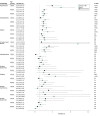Association of Traumatic Brain Injury With the Risk of Developing Chronic Cardiovascular, Endocrine, Neurological, and Psychiatric Disorders
- PMID: 35482306
- PMCID: PMC9051987
- DOI: 10.1001/jamanetworkopen.2022.9478
Association of Traumatic Brain Injury With the Risk of Developing Chronic Cardiovascular, Endocrine, Neurological, and Psychiatric Disorders
Abstract
Importance: Increased risk of neurological and psychiatric conditions after traumatic brain injury (TBI) is well-defined. However, cardiovascular and endocrine comorbidity risk after TBI in individuals without these comorbidities and associations with post-TBI mortality have received little attention.
Objective: To assess the incidence of cardiovascular, endocrine, neurological, and psychiatric comorbidities in patients with mild TBI (mTBI) or moderate to severe TBI (msTBI) and analyze associations between post-TBI comorbidities and mortality.
Design, setting, and participants: This prospective longitudinal cohort study used hospital-based patient registry data from a tertiary academic medical center to select patients without any prior clinical comorbidities who experienced TBI from 2000 to 2015. Using the same data registry, individuals without head injuries, the unexposed group, and without target comorbidities were selected and age-, sex-, and race-frequency-matched to TBI subgroups. Patients were followed-up for up to 10 years. Data were analyzed in 2021.
Exposures: Mild or moderate to severe head trauma.
Main outcomes and measures: Cardiovascular, endocrine, neurologic, and psychiatric conditions were defined based on International Classification of Diseases, Ninth Revision (ICD-9) or International Statistical Classification of Diseases and Related Health Problems, Tenth Revision (ICD-10). Associations between TBI and comorbidities, as well as associations between the comorbidities and mortality, were analyzed.
Results: A total of 4351 patients with mTBI (median [IQR] age, 45 [29-57] years), 4351 patients with msTBI (median [IQR] age, 47 [30-58] years), and 4351 unexposed individuals (median [IQR] age, 46 [30-58] years) were included in analyses. In each group, 45% of participants were women. mTBI and msTBI were significantly associated with higher risks of cardiovascular, endocrine, neurologic, and psychiatric disorders compared with unexposed individuals. In particular, hypertension risk was increased in both mTBI (HR, 2.5; 95% CI, 2.1-2.9) and msTBI (HR, 2.4; 95% CI, 2.0-2.9) groups. Diabetes risk was increased in both mTBI (HR, 1.9; 95% CI, 1.4-2.7) and msTBI (HR, 1.9; 95% CI, 1.4-2.6) groups, and risk of ischemic stroke or transient ischemic attack was also increased in mTBI (HR, 2.2; 95% CI, 1.4-3.3) and msTBI (HR, 3.6; 95% CI, 2.4-5.3) groups. All comorbidities in the TBI subgroups emerged within a median (IQR) of 3.49 (1.76-5.96) years after injury. Risks for post-TBI comorbidities were also higher in patients aged 18 to 40 years compared with age-matched unexposed individuals: hypertension risk was increased in the mTBI (HR, 5.9; 95% CI, 3.9-9.1) and msTBI (HR, 3.9; 95% CI, 2.5-6.1) groups, while hyperlipidemia (HR, 2.3; 95% CI, 1.5-3.4) and diabetes (HR, 4.6; 95% CI, 2.1-9.9) were increased in the mTBI group. Individuals with msTBI, compared with unexposed patients, had higher risk of mortality (432 deaths [9.9%] vs 250 deaths [5.7%]; P < .001); postinjury hypertension (HR, 1.3; 95% CI, 1.1-1.7), coronary artery disease (HR, 2.2; 95% CI, 1.6-3.0), and adrenal insufficiency (HR, 6.2; 95% CI, 2.8-13.0) were also associated with higher mortality.
Conclusions and relevance: These findings suggest that TBI of any severity was associated with a higher risk of chronic cardiovascular, endocrine, and neurological comorbidities in patients without baseline diagnoses. Medical comorbidities were observed in relatively young patients with TBI. Comorbidities occurring after TBI were associated with higher mortality. These findings suggest the need for a targeted screening program for multisystem diseases after TBI, particularly chronic cardiometabolic diseases.
Conflict of interest statement
Figures



Comment in
-
Traumatic Brain Injury and Chronic Implications Beyond the Brain.JAMA Netw Open. 2022 Apr 1;5(4):e229486. doi: 10.1001/jamanetworkopen.2022.9486. JAMA Netw Open. 2022. PMID: 35482314 No abstract available.
References
MeSH terms
LinkOut - more resources
Full Text Sources
Other Literature Sources
Medical

